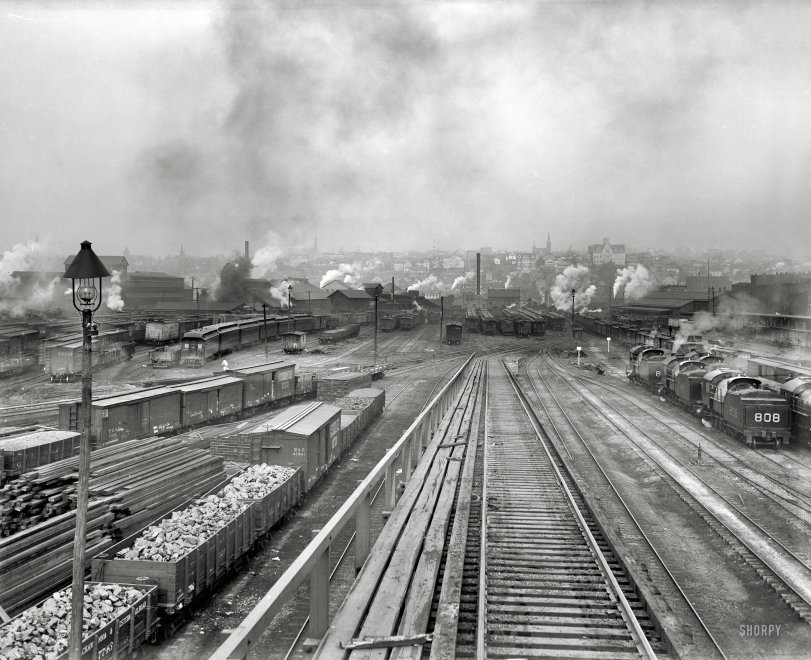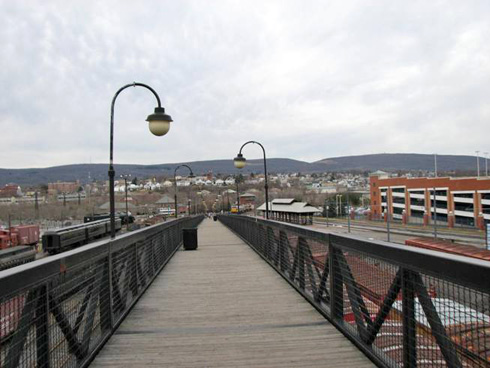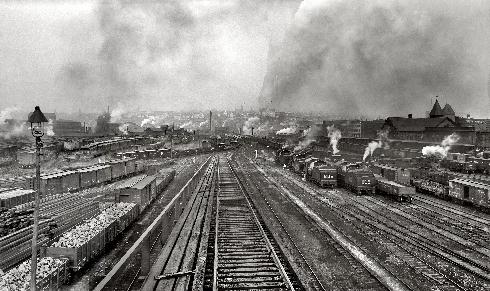


Framed or unframed, desk size to sofa size, printed by us in Arizona and Alabama since 2007. Explore now.
Shorpy is funded by you. Patreon contributors get an ad-free experience.
Learn more.

- Details, Details
- What's that building to the left of the tower?
- Coal Barges
- Bromo-Seltzer
- Inner harbor
- The Basin
- What a headache!
- Giant stepladder?
- Baldwin 62303
- Baldwin VO-1000
- Cold
- No expense spared
- Tough Guys
- Lost in Toyland
- And without gloves
- If I were a blindfolded time traveler
- Smoke Consumer Also Cooks
- Oh that stove!
- Possibly still there?
- What?!?
- $100 Reward
- Freeze Frame
- Texas Flyer wanted
- Just a Year Too Soon
- WWII -- Replacing men with women at the railroad crossing.
- Yes, Icing
- You kids drive me nuts!
- NOT An Easy Job
- I wonder
- Just add window boxes
Print Emporium
Scranton: 1900

Scranton, Pennsylvania, circa 1900. "Delaware, Lackawanna, and Western Railroad yards." Judging by the fellow in the white coveralls, I'd say this plate was exposed not long after this one. Detroit Publishing Co. View full size.
re: Where do you worka John?
In the version I heard, "I poosh, I poosh, I poosh" was followed by 'Poosha, poosha, poosha, poosha, -poosha, poosha, poosha."
I was a railroad freight handler in 1955 and I actually heard an Italian freight handler say "poosha" in connection with moving some freight.
Same Location Scranton DL&W Rail Yards now
My picture taken from approx. the same location. The old DL&W rail yards are now Steamtown National Historic Site.

Industrial steeples
Not mentioned yet is the forest of church steeples across the skyline. As with many industrial towns, Scranton's population had many countries represented and each ethnicity usually had its own church. My wife's from Scranton, and I remember parking in the lot of a (perhaps) German parish to go to Christmas Mass in the Slovak parish church on the same block. Or maybe it was an Italian parish.
A bit of that Hades-like scene remains today in Scranton as the Steamtown National Historic Site railroad museum, a National Park Service attraction.
DL&W, et al
Wonderful of the Scranton DL&W yards, but this was not the only rail operator. Vestiges of track can be found all around Scranton and the adjoining towns. The major players included the St. Lawrence & Hudson, Deleware & Hudson, NY-Ontario & Western, Jersey Central, Erie, Reading & Northern, and of course, DL&W. It is said that some 35 freight lines operated through Scranton at one time or another. In addition, the area was served by light rail, interurban, and trolley companies. The buildings just visable at right in the photo are, of course, long gone and replaced by a shopping mall.
Rock Island boxcar
Two tracks behind locomotive 808 is a Rock Island boxcar. On the left side of the boxcar are the words "Chicago, Rock Island and" (with "Pacific" being obscured.) The right side of the boxcar shows the earliest primitive Rock Island Route "beaver skin" logo. If this image was taken in 1900, then this would predate the oldest known image of the logo by two years. Unfortunately, the boxcar is missing from the stitched version.
Pretty hellish if you ask me
Of course, no one asked me. But jeez, what a hellish scene. Lung-blackening coal dust, soot, poisonous coal fires, smog from all the steam, steel shavings and dust from screeching wheels on tracks. I'm surprised you didn't drop dead after an hour here.
I love the old railroads anyway.
DL&W
We tend to get all nostalgic when we think of railroad travel "back in the day," but it wasn't always perfect efficiency. When my grandmother used to ride the DLW a hundred years ago, they used to joke that the letters stood for Delay, Linger and Wait.
Stub end tracks
What's amazing is the stub end tracks without bumpers or wheel stops on the ends, must of been interesting to park cars on these tracks if you didn't have a brakeman spotting the cars. The box car on the left # 33551 as I can make out, looks like it ran off the end. Also notice the really neat camelback locos on the right. The engineer rode in the cab right next to the boiler (must have been real hot in the summer) while the fireman rode on the rear, stoking the fire, which wasn't much of a comfortable ride either, especially on rough track. Great photo and so clear after 110 yrs.
MDTC
In the middle-ground about five or so tracks from the left edge of the photo (just to the right of the gas lamp in the foreground), is a Merchants Despatch Transportation Co. freight car, such as seen in this recent Shorpy image:
https://www.shorpy.com/node/8252
It's the only MDTC car "representing" in the Scranton image, and the serial number doesn't match, but it's still a pretty cool coincidence.
Scranton D, L & W RR yards
The two images Scranton: 1900 and Old King Coal: 1900 put together, using some cut & paste techniques. The difference is only one freight train, the smart observer Dave recognized the man in the white overalls, who seems to have solved the "bilocation" problem! View full size.

Tain't Graffiti
Back in those days, yard crews would scribble instructions on the car. Things like where it was going, fragile load, destination, repairs needed, etc. Makes switching a whole lot easier.
Contents and destination
Several men of my father's family worked these yards in Scranton. I remember him saying the yardmen would mark this information on the cars to aid in switching. He never said what happened when it rained!
Where do you worka John?
Where do you worka John?
On the Delaware Lackawan
What do you do-ah John?
I poosh I poosh I poosh.
Whata do you poosha John on the Delaware Lackawan?
On the Delaware Lackawan I poosh I poosh the broom
-- Song sung by my Italian grandmother, who grew up (after she got off of the boat) near the Jersey City terminus of the Delaware Lackawanna from about 1904 until 1922.
A Slippery Slope.
Both photos are taken from an elevated coaling trestle. Coal in bottom-dump gondola cars was pushed by a locomotive up the inclined trestle towards the camera onto a dead-end portion of level track (behind camera) which had sloped-bottom storage bins beneath.
The coal was then dumped thru holes in the trestle deck into the bins below.
Locomotives to be coaled were run along side the coal trestle at ground level, and then an upward-sliding door at the bottom of the coal bin was opened by the man taking coal, which allowed coal to flow down a chute and into the coal bunker in the tender of the locomotive being fueled.
Sand for locomotive traction was usually put into the sand domes of locomotives at or near the coal chutes using the same manpower for both tasks.
Sand was kept nearby and dried in the sand house around a coal-fired heater, then moved up to its bins above the service tracks and supplied by gravity to the sand domes on locomotives. On oil-fired locomotives sand would be put into a separate bunker behind the cab to be poured into a hole in the firebox door while the engine was working hard to remove the oil soot from the firebox walls, the firetubes and the superheater elements to improve heat transfer to water in the boiler.
Road locomotives were usually coaled and sanded on their arrival from a run before going to the roundhouse.
If the rails were wet, the engineer pushing cars of coal would have to take a run at the hill, yet, be ready to stop as soon as the cars reached the level track atop the coal chute, or they would go off the end.
The broken blocks of wood visible on the walkway to the left of the track would be used by switchmen to block the wheels of cars on the slope.
There is no walkway on the opposite side, as the engineer was on the right of the locomotive and would be pushing the cars on the front of the engine to keep the water in the boiler at the rear over the firebox.
If the roundhouse dispatched, say, 20 road locomotives a day, each requiring 10 tons of coal, would mean at least 200 tons of coal would have to be moved up the coal chute ramp (and the empties brought back down).
Using 40-ton cars would mean at least five cars a day up the slope.
The small yard locomotives would also take coal from time to time, but, as they were usually never out of sight of the coal chute, it was not as important to have a full tender when going to work on their shift.
The steepness of the grade might limit the yard engine to only two or three cars a trip up, as care had to be taken.
The sand would come in boxcars to keep it dry.
One major problem of the camelback locomotives shown to the right was that if one of their side rods or the main rod broke while in motion, the loose end still attached to the crank pin on a driving wheel would flail around, and wipe the cab and the engineer off the side of the locomotive.
If the engineer was incapacitated, or worse, and the throttle not shut, you could then have a runaway.
The "graffiti" on the sides of the boxcars is probably car destinations chalked on by yardmen at originating terminals.
In 1900, not all freight cars would have air brakes, and, generally, they would be handled at the rear of freight trains, the air brake cars and their air hoses coupled directly behind the locomotive.
Comparing the two photos, two switchmen can be seen riding the tops of boxcars to the right beyond the locomotives, they in position to relay hand signals to the engineer on their own locomotive in the distance when a coupling is being made onto other stationary cars.
At night lanterns would be used and an engineer would have to be sure he was watching the right lamp in a busy yard.
Switch stands would have oil lamps displaying standard colours to indicate their direction at night, and a wood or metal "target" by day.
In 1900, steam was still the lifeblood of industry and many plumes of steam can be seen both on and off the railway.
Another great photo!
Gritty City
Being a postwar baby and raised in Scranton, I too felt that carryover grime. And it somewhat extends to this day!
re: Graffiti
These chalk marks aren't the same as modern graffiti. Conductors would mark the cars and yardmen would use the marks to help breakup and classify the cars when they were in a yard.
Total Depth of Field
It would be interesting to know the details on how this photo is in focus from just a few feet from the light fixture to infinity. Is this a Shorpy/Dave technique or as is?
[It's a standard view-camera view. - Dave]
























On Shorpy:
Today’s Top 5